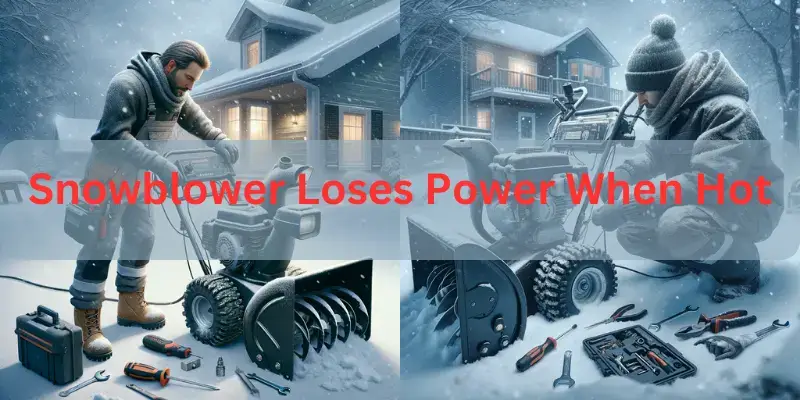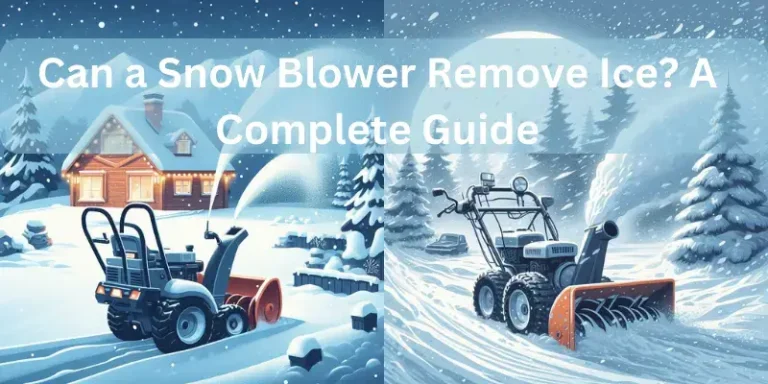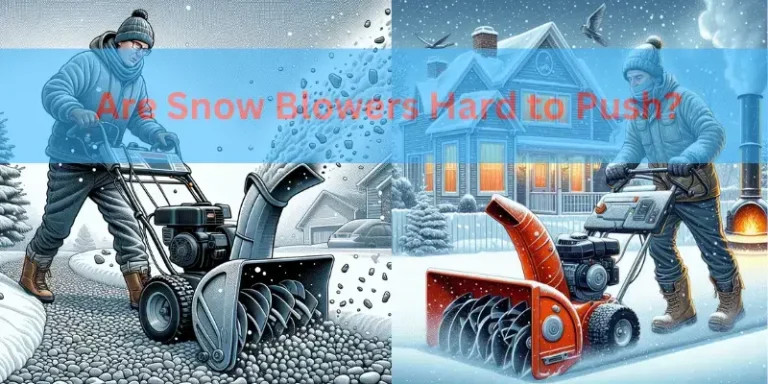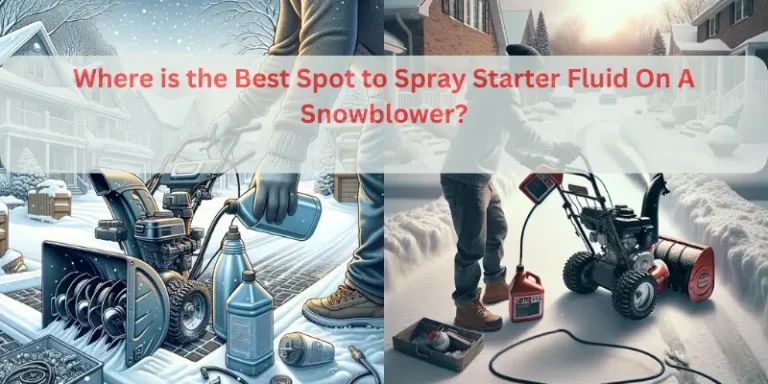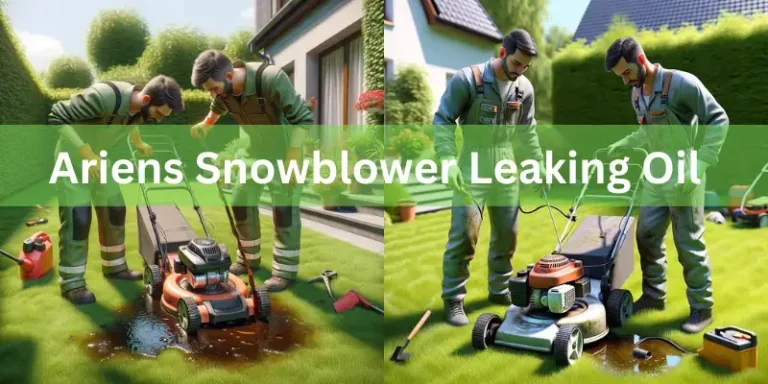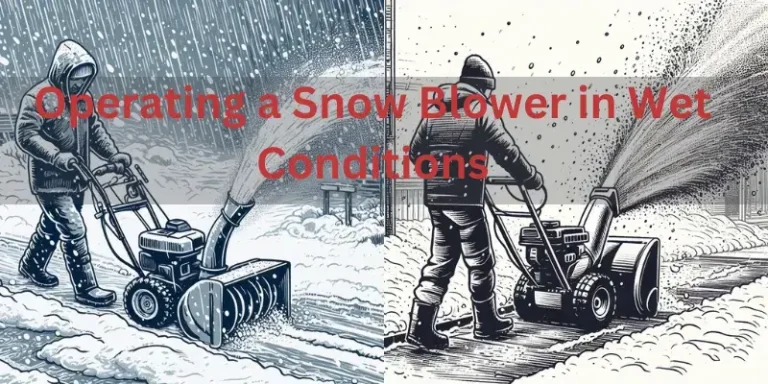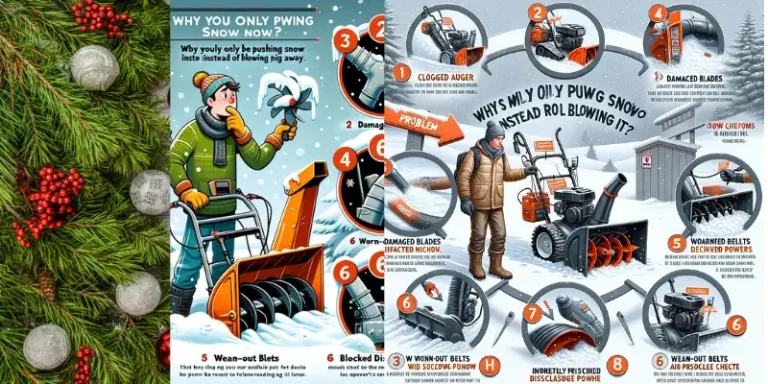Snowblower Loses Power When Hot – Troubleshooting & Easy Fixes
When the cold, wintry weather hits, your trusty snowblower becomes an essential tool for keeping your driveway and walkways clear. But what happens when your snowblower Loses Power When Hot?
Losing power when hot can be frustrating and leave you stuck with a half-cleared driveway. I will troubleshoot the problem step-by-step and provide you with easy tips to resolve the hot start problem in your snowblower.
“Hot start/Losing Power issues in snowblowers often occur due to common factors like a faulty spark plug, damaged armature, worn-out valves, or a clogged gas cap. To address these problems, you’ll need to diagnose the specific issue and replace or clean the affected component. In this guide, we’ll walk you through the troubleshooting steps and easy fixes to get your snowblower running smoothly again, ensuring you can clear your driveway effectively in the winter months.”
How Common Are Hot Start Issues in Snowblowers?
Let’s start by examining and troubleshooting the most common causes behind hot start problems in snowblowers:
Spark Plug: Igniting Performance
A faulty spark plug can often be the root cause of power loss when hot. The spark plug plays a vital role in igniting the fuel-air mixture in the engine. When it’s not working correctly, your snowblower may lose power or struggle to start when hot. Here’s how to diagnose and address this issue:
Symptoms of a Faulty Spark Plug
- Power loss when hot
- Difficulty starting the engine
- Misfiring
- Poor fuel economy
Diagnosis and Fix
Check the Spark Plug:
Inspect the spark plug for signs of wear, such as fouling, corrosion, or damage to the electrode. If it appears worn or damaged, it’s time for a replacement.
Replace the Spark Plug:
Remove the old spark plug and replace it with a new one of the same type and size. Be sure to set the gap to the manufacturer’s specifications.
Armature Issues in Snow Blower
The armature is another component that can cause power loss when hot. It is responsible for producing the spark that ignites the fuel-air mixture. A damaged armature can lead to a weak spark or no spark at all, resulting in a loss of power when hot. Here’s how to diagnose and address this problem:
Symptoms of a Damaged Armature
- Power loss when hot
- Weak or no spark
Diagnosis and Fix
Test the Armature:
Use a multimeter to check the armature’s resistance. If the reading is significantly higher or lower than the manufacturer’s specifications, it’s time to replace the armature.
Replace the Armature:
Remove the old armature and install a new one that matches your snowblower’s make and model.
Damaged and Worn-Out Valves
Worn-out valves can also contribute to power loss when hot. Valves control the flow of air and fuel into the engine and exhaust gases out of the engine. When they are worn, you may experience reduced power when your snowblower gets hot. Here’s how to diagnose and address this issue:
Symptoms of Worn-out Valves
- Power loss when hot
- Rough idle
- Reduced power
- Poor fuel economy
Diagnosis and Fix
Inspect the Valves:
Remove the valve cover and inspect the valves for signs of wear and tear. If you notice pitting, carbon buildup, or bent valve stems, it’s time for replacement.
Replace the Valves:
Replace both the intake and exhaust valves with new ones that match your snowblower’s specifications. Be sure to properly seat and adjust the valves.
Gas Cap Problem: Power Lose in SnowBlower
A clogged or malfunctioning gas cap can cause power loss when hot by preventing the proper flow of fuel to the engine. This can lead to reduced power when your snowblower gets hot. Here’s how to diagnose and address this issue:
Symptoms of a Clogged Gas Cap
- Power loss when hot
- Reduced power
Diagnosis and Fix
Inspect the Gas Cap:
Remove the gas cap and check for signs of clogging, such as a blocked vent or a damaged seal. Clean the cap or replace it if necessary.
Clean or Replace the Gas Cap:
If the gas cap is clogged, clean it thoroughly to ensure proper venting. If it’s damaged, replace it with a new one designed for your snowblower.
Less Common Causes of Power Loss When Hot
While the previously mentioned issues are the most common causes of power loss when your snowblower gets hot, there are other, less common culprits you should be aware of:
Bad Fuel Issues
Using old or contaminated fuel can lead to power loss when hot in snow blowers. Bad fuel can cause reduced power, misfiring, and difficulty starting the engine when your snowblower gets hot. Here’s how to diagnose and address this issue:
Symptoms of Bad Fuel
- Power loss when hot
- Difficulty starting the engine
- Misfiring
Diagnosis and Fix
Drain Old Fuel:
Empty the fuel tank and drain any old or contaminated fuel.
Replace with Fresh Fuel:
Fill the tank with fresh, high-quality gasoline that is suitable for your snowblower.
Vacuum Leaks Issues
Vacuum leaks in the engine’s intake system can disrupt the air-fuel mixture and lead to power loss when hot. Symptoms of vacuum leaks include a rough idle, reduced power, and poor fuel economy. Here’s how to diagnose and address this issue:
Symptoms of Vacuum Leaks
- Power loss when hot
- Rough idle
- Reduced power
- Poor fuel economy
Diagnosis and Fix
Use a Vacuum Gauge:
Connect a vacuum gauge to the intake manifold and monitor the reading. A fluctuating or low vacuum reading may indicate a vacuum leak.
Inspect and Repair Leaks:
Carefully inspect the intake manifold, vacuum hoses, and gaskets for any signs of damage or leaks. Replace or repair any damaged components.
Overheating Engine
An overheating engine can also contribute to power loss when hot. When the engine gets too hot, it can become difficult to start, misfire, and lose power. Here’s how to diagnose and address this issue:
Symptoms of an Overheating Engine
- Power loss when hot
- Difficulty starting the engine
- Misfiring
- Reduced power
Diagnosis and Fix
Check Engine Temperature:
Use a thermometer to measure the engine’s temperature. If it exceeds the recommended operating temperature, it’s overheating.
Repair the Cooling System:
Inspect the cooling system components, including the radiator, coolant level, and water pump. Replace any faulty parts and ensure proper coolant circulation.
Choke Problem
A faulty choke can hinder the starting process and cause power loss when hot. When the choke is not functioning correctly, you may experience difficulty starting the engine and reduced power when your snowblower gets hot. Here’s how to diagnose and address this issue:
Symptoms of a Faulty Choke
- Power loss when hot
- Difficulty starting the engine
- Reduced power
Diagnosis and Fix
Inspect the Choke:
Examine the choke for signs of wear or damage. Ensure that it opens and closes properly.
Replace the Choke:
If the choke is damaged or not functioning correctly, replace it with a new one that matches your snowblower’s specifications.
FREQUENCY ASK QUESTIONS (FAQs)
Why does my snowblower lose power when it’s hot?
One possible reason for this issue is that the engine may be overheating, causing it to stall. Check for any obstructions that could be blocking the airflow around the engine.
What maintenance should I perform to prevent my snowblower from losing power when hot?
It’s essential to regularly clean and replace the air filter, as a clogged filter can cause the engine to overheat and lose power. Additionally, ensure that the engine oil is at the correct level and is not old or contaminated.
Can using a lower-grade fuel cause my snowblower to lose power when it’s hot?
Yes, using a lower-grade fuel or fuel with a high ethanol content can lead to engine knocking and a reduction in power, especially when the engine is hot. Use fuel with the recommended octane rating and avoid fuel with more than 10% ethanol.
How can the spark plug affect the performance of my snowblower when it’s hot?
A worn or fouled spark plug can cause the engine to misfire and lose power, particularly when it’s hot. Regularly check and replace the spark plug according to the manufacturer’s recommendations to maintain optimal performance.
What role does the carburetor play in my snowblower losing power when hot?
A dirty or clogged carburetor can lead to a lean fuel mixture, resulting in reduced power and potential stalling when the engine is hot. Clean or rebuild the carburetor as part of routine maintenance to prevent this issue.
Should I be concerned if my snowblower loses power only after I’ve been using it for a while?
Yes, this could indicate an electrical problem such as a short in the wiring or a failing ignition coil. Inspect the electrical components and wiring for any signs of damage or wear, and address any issues promptly.
Could a clogged fuel filter be causing my snowblower to lose power when it’s hot?
Absolutely, a clogged fuel filter can restrict fuel flow to the engine, leading to a loss of power, particularly when the engine is hot. Replace the fuel filter at the recommended intervals to maintain proper fuel delivery.
Is there a way to prevent my snowblower from losing power when it’s hot without taking it to a professional?
Regular maintenance, such as cleaning or replacing the air filter, spark plug, fuel filter, and carburetor cleaning, can often resolve the issue of power loss when the snowblower gets hot. Refer to the owner’s manual for specific maintenance procedures.
Can watching a YouTube tutorial help me troubleshoot and fix my snowblower’s loss of power when hot?
Yes, many DIY guides and tutorials are available on YouTube that can guide you through troubleshooting and fixing common issues that can cause a snowblower to lose power when hot. Always ensure the source is reputable and the instructions align with the specific make and model of your snowblower.
What measures can I take to prevent my snowblower from losing power when it’s hot?
In addition to regular maintenance, ensure that you are operating the snowblower in the recommended conditions, such as proper fuel and oil levels, and avoid overloading the machine. Operating the snowblower within the manufacturer’s guidelines can help prevent power loss when the machine gets hot.
Conclusion
Power loss when your snowblower gets hot can be a frustrating experience, especially during the winter season. However, with the knowledge of common causes and troubleshooting techniques, you can keep your machine in top working condition.
By following these troubleshooting steps and practicing regular maintenance, you can ensure your snowblower maintains its power even when hot, allowing you to clear your driveway effectively in the coldest weather conditions.
To prevent power loss issues in the future, use high-quality fuel, perform regular maintenance checks, and store your snowblower properly during the off-season. With these tips, you’ll be well-equipped to tackle winter’s challenges and keep your driveway clear of snow and ice.

About Naveed A Hashmi
In my childhood, I used to see my parents while working in the land, for these reasons today I have been serving the same as our own tradition and culture. I thus love to stay in it, because I want to learn something advanced and new so that I may improve my farm’s contour and help others with my experience.

